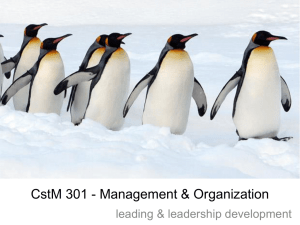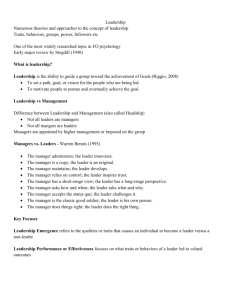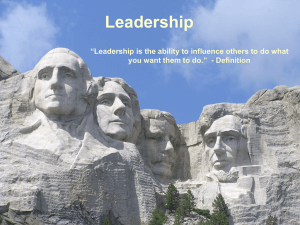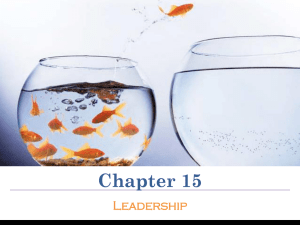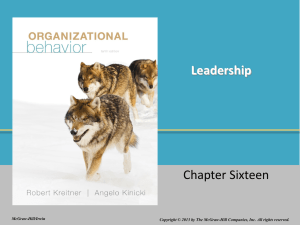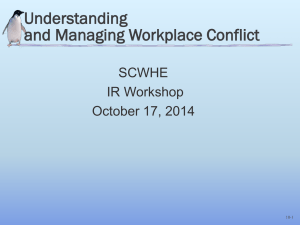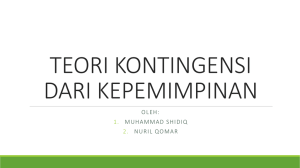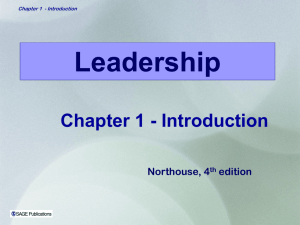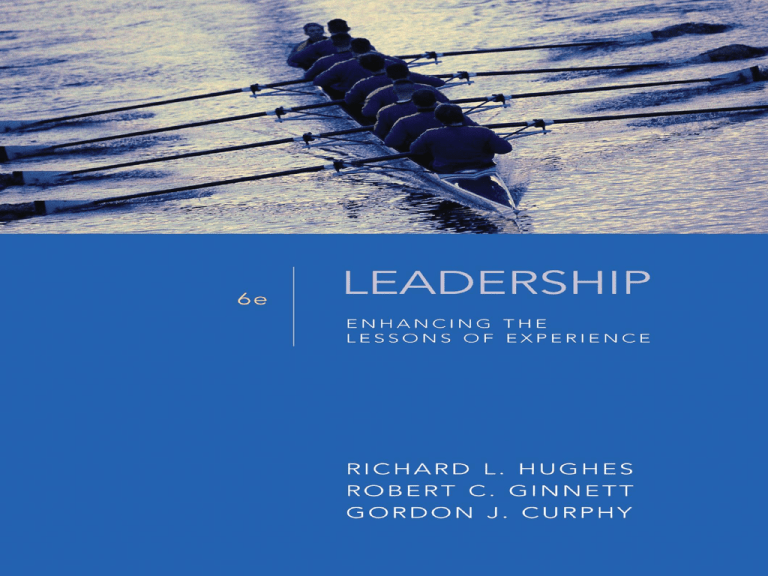
11-1
Chapter
11
Characteristics of the Situation
“When you’ve exhausted all possibilities,
remember this: You haven’t!”
~Robert H. Schuller
McGraw-Hill/Irwin
copyright © 2009 by The McGraw-Hill Companies, inc. All Rights Reserved
1-2
Background
• The appropriateness of a leader’s behavior with
a group of followers often makes sense only in
the situational context in which the behavior
occurs.
• The situation, not someone’s traits or abilities,
plays the most important role in determining
who emerges as a leader.
• Great leaders typically emerged during
economic crisis, social upheavals, or
revolutions.
– It was believed that leaders were made, not
born, and that prior leadership experience helped
forge effective leaders.
11-3
Situational Factors That Affect
Leaders’ Behaviors
• Role theory: A leader’s behavior depends on a
leader’s perceptions of several critical aspects
of the situation:
– Rules and regulations governing the job.
– Role expectations of subordinates, peers, and
superiors.
– Nature of the task.
– Feedback about subordinates’ performance.
• Multiple-influence model
– Microvariables
– Macrovariables
• Situational levels: Task, organizational, and
environmental levels.
11-4
An Expanded Leader-FollowerSituation Model
11-5
From the Industrial Age to the
Information Age
• In the new information age, many
fundamental assumptions of the industrial
age are becoming obsolete.
• Changes in the ways companies operate:
–
–
–
–
–
–
Cross functions
Links to customers and suppliers
Customer segmentation
Global scale
Innovation
Knowledge workers
11-6
A Congruence Model
11-7
The Work – Job Characteristics
• Skill variety: Degree to which a job involves
performing a variety of different activities or skills.
• Task identity: Degree to which a situation or task
requires completion of a whole unit of work from
beginning to end with a visible outcome.
• Task significance: Degree to which a job
substantially impacts others’ lives.
• Autonomy: Degree to which a job provides an
individual with some control over what and how he
does it.
• Feedback: Degree to which a person accomplishing
a task receives information about performance from
performing the task itself.
11-8
The Work – Task Structure
• People vary in their preferences for, or ability to
handle, structured versus unstructured tasks.
• Subordinates need help when:
– A task is unstructured.
– They do not know what the desired outcome
looks like.
– They do not know how to achieve the outcome.
• Reducing the degree of ambiguity inherent in
an unstructured situation is a leadership
behavior usually appreciated by followers.
11-9
The Work – Task Interdependence
• Task interdependence: Degree to which
tasks require coordination and
synchronization for work groups or teams
to accomplish desired goals.
• Tasks with high levels of interdependence
place a premium on leaders’ organizing and
planning, directing, and communication
skills.
• Task interdependence can also dictate
which leader behaviors will be effective in
a particular situation.
11-10
The People
• Leaders should look at the followers in
terms of:
–
–
–
–
–
–
Skills
Knowledge
Experience
Expectations
Needs
Preferences
• In a rapidly changing environment,
diversity allows the species to sense and
adapt more quickly.
• Diversity is essential to quality and survival
in a rapidly changing world.
11-11
The Formal Organization – Level of
Authority
• Level of authority: One’s hierarchical level in
an organization.
• The types of behaviors most critical to
leadership effectiveness can change
substantially as one moves up an
organizational ladder.
• Leaders at high organizational levels often
perform a greater variety of activities and are
more apt to use participation and delegation.
11-12
The Formal Organization –
Organizational Structure
• Organizational structure: The way an
organization’s activities are coordinated and
controlled, and represents another level of
the situation in which leaders and followers
must operate.
• Organization structure can be thought of in
three terms:
– Complexity:
• Horizontal complexity
• Vertical complexity
• Spatial complexity
– Formalization: Degree of standardization.
– Centralization: Diffusion of decision making.
11-13
Organizational Design - Functional
Design
11-14
Organizational Design – Product
Design
11-15
Organizational Design – Matrix
Design
11-16
Organizational Design – Lateral
Interdependence
• Lateral interdependence: Degree of
coordination or synchronization required
between organizational units in order to
accomplish work-group or organizational
goals.
• Leaders are more likely to use rational
persuasion as an influence tactic when the
level of lateral interdependence is high.
11-17
The Informal Organization
• Organizational culture: System of shared
backgrounds, norms, values, or beliefs
among members of a group.
• Organizational climate: Members’
subjective reactions about the organization.
• Leaders can change culture by attending
to or ignoring particular issues, problems, or
projects.
• Leaders can modify culture
– Through their reactions to crisis
– By rewarding new or different kinds of behavior
– By eliminating previous punishments or negative
consequences for certain behaviors.
11-18
Some Questions That Define
Organizational Culture
11-19
Environmental Characteristics
• Environmental characteristics: Situational
factors outside the task or organization that
still affect the leadership process.
• These factors include:
–
–
–
–
–
Technological forces
Economic forces
Political forces
Social forces
Legal forces
• These factors often create anxiety, and
therefore cause an increase in employees’
security needs.
11-20
Technology and Uncertainty
• Environments of low technological
complexity: Workers play a large role and
are able to modify their behavior depending
on the situation.
– A range of technological complexity can exist.
• Different kinds of organizational structures
or designs are best suited for different
technological environments.
• The degree of environmental uncertainty
affects optimal organizational design.
11-21
Crisis
• Behaviors associated with effective
leadership during crises differ from those
associated with noncrisis situations.
• During crises, followers are more likely to
look to leaders to identify the problem as
well as develop and implement a solution.
• Leaders are less apt to use participation or
consultation during crises.
11-22
Situational Engineering
• A leader or follower can become more
effective by identifying problem areas and
restructuring the situation so that
problems become easier to overcome.
• A variety of ways in which leaders and
followers can change the task,
organizational, and environmental factors
affecting their behaviors and attitudes exist.
• Leaders and followers must think about how
they can change the situation for everyone
to be more satisfied and productive.
11-23
Summary
• The situation may well be the most complex factor in
the leader-follower-situation framework.
• Situations vary not only in complexity but also in
strength.
• The Congruence Model can be used as a way to
consider many of the situational factors leaders
should consider.
• Research has shown that organizational factors play
a major role in the leader-situation framework.
• The informal organization or the organizational
culture can have a profound impact on the way both
leaders and followers behave.
• Factors in the environment, such as legal, political,
or economic forces, can also affect leaders’ and
followers’ behaviors.
11-24

